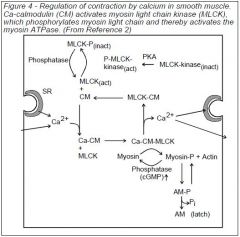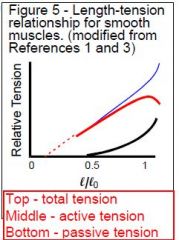![]()
![]()
![]()
Use LEFT and RIGHT arrow keys to navigate between flashcards;
Use UP and DOWN arrow keys to flip the card;
H to show hint;
A reads text to speech;
21 Cards in this Set
- Front
- Back
|
Diagram Smooth Muscle
|

|
|
|
Characteristics of SMC (verbal)
|
Characteristics smooth muscle: Absent sarcomeres, SMC are smaller than MSK/CARDIAC, no t-tubules, Caveolae have T-tubule like fx, well defined peripherally located SR, thick filament assemble opposing bidirectional, dense bodies = Z disc equiv. (actin), Int. filaments connect dense bodies, adhesive jxs hold cells together, some have gap jxs.
|
|
|
Characteristics Unitary SMC
|
Unitary smooth muscle – lots of gap junctions = synctium behavior, freq. exhibit spontaneous activity, Have low-mod ANS innervation, ↑activity when stretched. (?? Where)
|
|
|
Characteristics Multiunit SMC
|
Multiunit smooth muscle – sparse/absent gap junctions, coordination occurs at neural level. Thus each cell receives neural input. (pilomotor muscles, vas deferens, ciliary body)
|
|
|
Define Syncital behavior
|
Syncitial behavior – synchronous contraction of multiple cells. Requires communication (gap junctions)
|
|
|
Compare & Contrast Electro/pharm-Mechano coupling
|
Electro-mechanical coupling – activation involves ∆EM
Pharm-mechanical coupling – activation involves ligand (rx, hormone) –receptor interaction. Leads to signaling cascades. Some cells use BOTH |
|
|
How SMC are senstive
|
SMC sensitivity – low noise (↓permeability) allows small signals. ↓ resting membrane depolarization (↓permeability K+ ). Lower resting (tonic) tone means more contracted. (It sits in a partially contracted state)
|
|
|
Stores of Ca and release
|
Ca source - SR (Ca induced/ IP3 intracellular messenger) or extracellular (VG-Ca channels/ligand – Ca channels)
If SR Ca2+ is depleted then membrane Ca opens to 1. Sustain contraction 2. Replenish SR Ca store |
|
|
Steps in SMC of force contraction
|
1. Ca binds Calmodulin (CAM)
2. Ca-CAM binds & activates Myosin light chain kinase (MLCKact) 3. MLCKact phosph. MLC → active myosin* 4. Myosin* binds to actin & X-bridge cycling occurs 5. Phosphatase de-phosph. MLC → MLCdeactivated 6. Cas re-sequestered/pumped out cell → MLCKinactive 7. “Latch” mech → Tension maintained despite step 5&6 8. Tension fx(balance MLC de-phosph&phosph activity) |
|
|
PKA affect on MLCK
|
PKA phosphorylation of MLCK ↓Ca sensitivity, Sliding filament w/ slower ATPase (cycling) & NO troponin(blocks active site)
|
|
|
Diagram of Smooth Muscle Cycling
|

|
|
|
Force-Length Relationship - SMC
|

|
|
|
Contractile Properties of SMC
|
Absence of sarcomeres = generates force wider range of lengths (contracts to 25% Lmax vs. 50-60% SKM)
Sliding filament same, BUT regulation is ∆: 1.myosin assembly & 2.slow ATPase |
|
|
Tension and Ca
|
Tension varies as a function Ca availability.
Tension varies fx of sensitivity of regulatory proteins for Ca ∆ (affinity of MLCK for Ca-CAM ↓ when MLCK is phosphorylated (protein kinase A) |
|
|
Types SMC signals
|
neural
humoral stretch Metabolites Neighboring Unitary Cell |
|
|
Describe Neural SMC signaling
|
Neural – Cell bodies ANS lie plexi/ganglia outside CNS. Utilize Ach, NE, ATP, Peptide NTs. Atypical nerve-SMS jx. Varicosities – “swellings” along length w/ ↑vesicles, though 1. Vesicle release can occur along length & 2. jx cleft can vary in size. Both result in less localized signaling.
|
|
|
Describe Humoral SMC signaling
|
Humoral (hormone)– adrenal gland, kidney, other endocrine glands, pharma, ingested subst. = ligand receptors. Utilize Epinephrine & angiotensin (renin→kidney)
|
|
|
Describe Stretch SMC signaling
|
Stretch – activates stretch (Non specific Cationic channels = depolarizarization) receptors. Stimulated by food bolus, BP ect.
|
|
|
Describe Metabolites SMC signaling
|
Metabolites – Receptors for extracellular/intracellular molecules related to state of cell. CO2 , pH , lactic acid , ATP/ADP , adenosine , NO ect.
|
|
|
Describe Intercellular SMC signaling
|
Neighboring unitary SMS – 1.release signaling molecules & 2.electrical ∆ through gap jxs.
|
|
|
Describe 2nd messengers involved in SMC
|
1. Receptors coupled to cAMP (and cGMP) generally inhibit contractile activity
2. Receptors coupled to Phospholipase C and IP3 are generally stimulatory 3. In "rest and vegetative" smooth muscles (e.g. intestine) a. contraction is augmented by parasympathetics and decreased by sympathetics b. ACh interacts with muscarinic (rather than nicotinic) receptors 4. In "fight or flight" smooth muscles (e.g. blood vessels of striated muscles) a. contraction is augmented by the sympathetics |

